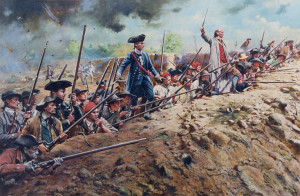In a small business, underused technology could be considered a “Bunker Hill” error in using your competitive capabilities.
Last Wednesday, June 17th, marked the 240th anniversary of the Battle of Bunker Hill. Ranked as the 6th most costly battle of the Revolution in terms of lives, most Americans forget that it was actually fought over a year before we declared independence. (on 4/4/76) It was far larger than the skirmishes at Lexington and Concord two months before, involving about 1,500 Colonial Militia and 2,500 British Regulars.
 What has always fascinated me about the battle is the Americans’ poor use of superior technology. Prior to the first British attack, Colonel John Stark drove a stake 100 feet in front of the fortifications, with orders to hold fire until the British soldiers passed that point. This tactic was further reinforced by the command (attributed variously to William Prescott and several other officers) “Don’t fire until you see the whites of their eyes.”
What has always fascinated me about the battle is the Americans’ poor use of superior technology. Prior to the first British attack, Colonel John Stark drove a stake 100 feet in front of the fortifications, with orders to hold fire until the British soldiers passed that point. This tactic was further reinforced by the command (attributed variously to William Prescott and several other officers) “Don’t fire until you see the whites of their eyes.”
That command shows up in documentation of previous wars, since it was the common tactic of musket-equipped armies. Smooth-bore military muskets had limited range or accuracy, and were most effective when fired en masse at close range.
The problem with those tactics on the American side is simple. Their troops didn’t have smooth-bore muskets. As militia, the Colonial soldiers provided their own weapons, hunting pieces that were designed to be accurate at a far greater range than the military weapons. They had rifled barrels, allowing effective aiming at 300 feet, and over 500 feet for an especially well-made gun.
The American superiority in targeting ability is also borne out by the casualty statistics. Of the nearly 1,000 British soldiers killed and wounded in the battle, 100 were officers. The typical British unit had about a 30:1 enlisted to officer ratio in the field, which would indicate there should have been about 35 officer casualties from random hits in mass volleys.
How did the Americans inflict triple the expected number of casualties on officers? Because they could aim. Using their superior technology, they crippled the entire British officer corps for months to come. Unfortunately, the American officers managed the bigger battle around the traditional limitations of lesser technology, and lost when the British swarmed the breastworks with bayonets.
Is your business managing around outdated technology? I’m not suggesting that you run out and buy all new computers. However, like the Continental Army, many small businesses use only a fraction of the technology they already own.
“We file paper copies of customer statements, because it is easier to put our hands on them.” “We started a blog, but I don’t think we’ve looked at it in months.” We don’t use cloud-based software, because we wouldn’t know where our stuff was.” We installed a CRM, but no one really updates it.” “We don’t collect email addresses from our customers, because they say that they get too much email already.” “We bought the comprehensive enterprise software, but we’ve only implemented the basic functions.”
Your technology is an asset, and the role of any business leader is to maximize the return on assets. Hanging onto the way you’ve always done something when you already possess the technology to do better is a waste of the investment.
How would the Revolution have changed if the Americans had repelled the British attack at Bunker Hill, and still held artillery positions above Boston when George Washington arrived to assume command a couple of weeks later? Instead, they ignored the advantages of technology they already possessed…and lost.

2 Responses to Technology and Bunker Hill Tactics